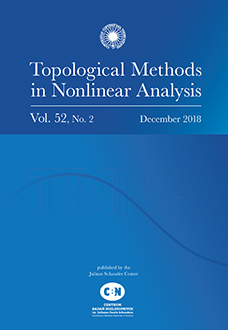Abstract
In this paper we consider a Neumann problem of the type $$ \begin{cases} -\Delta u = \alpha (x) (|u|^{q-2}u-u)+\lambda f(x,u) &\text{in } \Omega, \\ \displaystyle {\partial u\over \partial \nu}=0 &\text{on } \partial\Omega. \end{cases} \tag \hbox{$\text{\rm P}_{\lambda}$} $$ Applying the theory developed in [On a three critical points theorem, Arch. Math. (Basel) 75 (2000), 220–226], we establish, under suitable assumptions, the existence of an open interval $\Lambda\subseteq \mathbb R$ and of a positive real number $\varrho$, such that, for each $\lambda\in\Lambda$, problem (P$_{\lambda}$) admits at least three weak solutions in $W^{1,2}(\Omega)$ whose norms are less than $\varrho$.
Citation
Biagio Ricceri. "Three solutions for a Neumann problem." Topol. Methods Nonlinear Anal. 20 (2) 275 - 281, 2002.
Information





